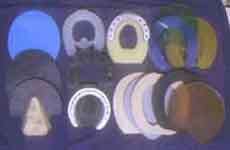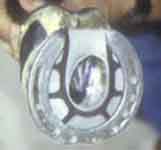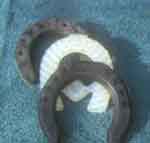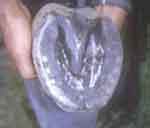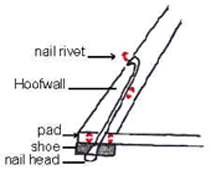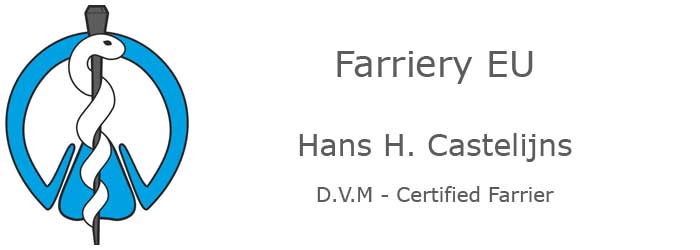 |
Shock absorbing shoeing techniques |
||||||||||||||||||||||||||||||||||||||||||||||||||||||||||||||||||||||||||||||||||||
1) Introduction:The unshod hoof has the capacity to absorb shock and high-frequency vibrations on impact with the hard ground. This capacity correlates with hoof shape and the moisture content of the hoof. The energy absorbed by the limb on initial impact of the hoof with the ground depends on:
It therefore follows that there is a special use for S.A. shoeing methods both in preventive and therapeutic shoeing for those horses called upon to perform on hard surfaces especially at speed. (Standardbreds come to mind but also endurance horses, carriage horses etc.). |
||||||||||||||||||||||||||||||||||||||||||||||||||||||||||||||||||||||||||||||||||||
2) Types of S.A. shoeing systemsS.A. shoeing systems can be divided into three groups: |
||||||||||||||||||||||||||||||||||||||||||||||||||||||||||||||||||||||||||||||||||||
|
||||||||||||||||||||||||||||||||||||||||||||||||||||||||||||||||||||||||||||||||||||
|
||||||||||||||||||||||||||||||||||||||||||||||||||||||||||||||||||||||||||||||||||||
Pads are available in a wide variety of materials, colours, prices and manufacturer's claims. They present the advantages of availability, moderate price and ease of application; on the other hand they have several weak points: Pads by themselves are not very efficient shock-absorbing systems when nailed between the hoof and the steel shoe, probably because a lot of impact energy (maximum deceleration and frequency of vibration) bypasses the pad through the nails embedded in the hoof wall. Furthermore, the total thickness of the shoeing system is increased, which is not without biomechanical consequences, the shoes need more and stronger nails to stay on (Fig. 1), some pads deteriorate rapidly (loss of "structural memory" and therefore S.A. capacity) and closed pads usually need packing to prevent thrush. The use of synthetic packing (e.g. silicone, polyurethane) can be useful to increase S.A. properties and to unload crushed and underrun heels, especially when applied all the way to the ground surface of the shoe (Fig. 2), but packing also increases the total weight of the shoeing system. |
||||||||||||||||||||||||||||||||||||||||||||||||||||||||||||||||||||||||||||||||||||
|
||||||||||||||||||||||||||||||||||||||||||||||||||||||||||||||||||||||||||||||||||||
Special S.A. shoes. These include a variety of commercial shoes, where the ground impact is dampened by the shock-absorbing properties of the materials they are made off. Aluminium is already more shock-absorbing then steel. Some models have a metallic insert embedded in S.A. material, such as rubber or polyurethane, which coming into contact with the ground first, dissipates energy. Glue-on shoes, owing to their less rigid attachment to the hoof wall (then the use of nails), preserve more of the hoof's ability to absorb energy. Special S.A. shoes have the advantage that they are indeed efficient at absorbing a lot of the high-frequency energy on impact, especially when their design and application precludes the nail heads from coming into contact with the ground. However they may give rise to some drawbacks relative to normal shoeing such as:
|
||||||||||||||||||||||||||||||||||||||||||||||||||||||||||||||||||||||||||||||||||||
ConclusionsThe ideal candidate for a preventive S.A. shoeing system is a horse that is called upon to work on hard surfaces. If these surfaces are solid (e.g. like city streets), the shoeing system should not provide too much grip. The ideal, one-type-fits-all, S.A. shoe does not exist yet. The choice of materials will have to take into account many elements, such as type, speed and quantity of work, type of surface, hoof quality etc. in order to come up with the best compromise for each particular horse and circumstance. The therapeutic, but especially the preventive, qualities of appropriate S.A. shoeing make it worth the effort though, indeed the equine health insurance industry has expressed interest in conducting long-term statistical studies into the incidence of injuries in horses shod normally versus those shod using a shock-absorbing system. |
||||||||||||||||||||||||||||||||||||||||||||||||||||||||||||||||||||||||||||||||||||
Hans Castelijns
D.V.M - Certified Farrier
